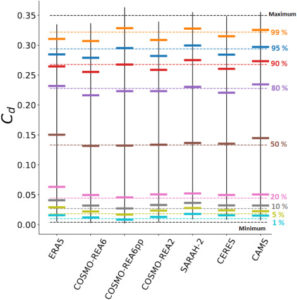Published in Solar Energy, Volume 232, 444–458, 2022:
Model estimates of expected photovoltaic (PV) power production rely on accurate irradiance data. Reanalysis and satellite products freely provide irradiance data with a high temporal and spatial resolution including locations for which no ground-based measurements are available. We assess differences in such gridded irradiance data and quantify the subsequent bias propagation from individual radiation components to capacity factors in a contemporary PV model. PV power production is simulated based on four reanalysis (ERA5, COSMO-REA6, COSMO-REA6pp, COSMO-REA2) and three satellite products (CAMS, SARAH‑2, CERES Syn1Deg). The results are compared against simulations using measurements from 30 weather stations of the German Weather Service. We compute metrics characterizing biases in seasonal and annual means, day-to-day variability and extremes in PV power. Our results highlight a bias of −1.4% (COSMO-REA6) to +8.2% (ERA5) in annual and spatial means of PV power production for Germany. No single data set is best in all metrics, although SARAH‑2 and the postprocessed COSMO-REA6 data (COSMO-REA6pp) outperform the other products for many metrics. SARAH‑2 yields good results in summer, but overestimates PV output in winter by 16% averaged across all stations. COSMO-REA6pp represents day-to-day variability in the PV power production of a simulated PV fleet best and has a particularly small bias of 0.5% in annual means. This is at least in parts due to compensating biases in local and seasonal means. Our results imply that gridded irradiance data should be used with caution for site assessments and ideally be complemented by local measurements.
Darragh Kenny and StephanieFiedler

